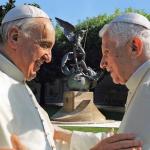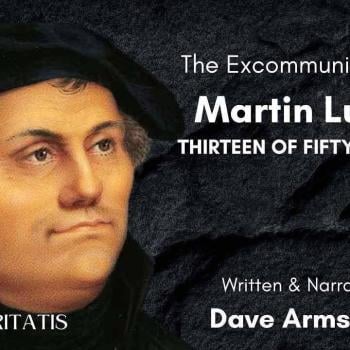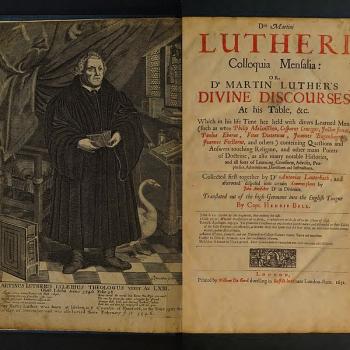Part Eight: Bombshell and Paradigm Shift: Blessed John Henry Cardinal Newman’s Essay on the Development of Christian Doctrine (1990)

This is the ten-part story of my complete religious history, from nominal Methodism (1958-1967), to the occult and practical atheism (1968-1976), through evangelical Protestantism, counter-cult, pro-life, evangelistic, and apologetics work (1977-1990), and finally on to the fullness of the Catholic faith in 1991. It is found complete (75 pages) in my 2013 book, Catholic Converts and Conversion.
See All Ten Parts:
Part One: Nominal Methodism, Occult, and the Seeds of a Serious Christian Commitment (1958 – early 1970s)
Part Two: Nature Mysticism, Romanticism, Bible Movies, and the “Great Depression” (1968-1977)
Part Three: Evangelical “Born-Again” (?) Experience, More Lukewarmness, and Personal Revival (1977-1982)
Part Four: Apologetics, Abundant Evangelical Blessings, and Protestant Evangelistic Campus Ministry (1983-1989)
* * * * *
Bombshell and Paradigm Shift: Newman’s Essay on the Development of Christian Doctrine
My Catholic friend, John McAlpine, confronted with the mass of jaded, highly selective historical evidence I had compiled, and my relentless polemics about supposed Catholic errors and additions through the centuries (citing and parroting Salmon, Küng, and Döllinger), was understandably frustrated and exasperated with my constant questions. I was getting into some pretty technical things: being thoroughly obnoxious, and he hadn’t done the study in the depth required to tackle my specific critiques, so, he didn’t have ready-made replies concerning Pope Honorius, and all these alleged “difficulties” in history.
As a way to counter my onslaught, he started urging me to read Blessed John Henry Cardinal Newman’s Essay on the Development of Christian Doctrine. What little familiarity I had with Newman had shown me that he was a very impressive figure. I knew that he was a brilliant Church historian and writer: highly respected by all, regardless of theological affiliation.
This book demolished the whole schema of Church history that I had painstakingly constructed. I thought, typically, that early Christianity was “simple” and Protestant and that Catholicism was a later corruption (although I placed the collapse in the late Middle Ages rather than the usual time of Constantine in the fourth century).
Martin Luther, so I reckoned, had discovered in Sola Scriptura the means to scrape the accumulated Catholic barnacles off of the original lean and clean Christian “ship.” Newman, in contrast, exploded the notion of a barnacle-free ship. Ships always got barnacles. The real question was whether the ship would arrive at its destination. Tradition, for Newman, was like a rudder and steering wheel, and was absolutely necessary for guidance and direction.
Newman brilliantly demonstrated the characteristics of true developments, as opposed to corruptions, within the visible and historically continuous Church instituted by Christ. A doctrine could grow and develop, but it doesn’t have to be a corruption (as in many Protestant views), because it remains the same in essence. We simply come to understand and comprehend it better, over time.
This notion is, I think, the key to Catholic history; why we think we’re the apostolic Church, that Protestantism broke away from, because their distinctive doctrines didn’t develop; they suddenly sprouted into existence. I found myself unable and unwilling to refute his reasoning, and a crucial piece of the puzzle had been put into place. Authoritative tradition was now plausible and self-evident to me.
I’d like to now examine, in considerable detail, my thought processes as I read Newman: how my thinking was revolutionized, since this is the central intellectual component of my change of mind and affiliation: the very “meat” of the “apologetic” aspect of my conversion.
I started reading the Essay on the Development of Christian Doctrine in October 1990, after having been somewhat “softened” in the previous months by my Catholic reading. The timing — in God’s Providence, and in retrospect — was perfect. I was ready to receive and be convinced by the arguments I was about to encounter: despite having fought so hard – almost ferociously – against infallibility.
Charles F. Harrold, the editor of an anthology of Newman’s writings, described the Essay as follows:
It was composed in 1845, when Newman was halting midway between two forms of Christianity . . . Its aim was to explain and justify what Protestants regarded as corruptions and additions to the primitive Christian creed, and to show these to be legitimate developments . . . In a series of eloquent and erudite analogies, he seeks to show that the present highly complex doctrines of the Church lay in germ in the original depositum of faith, which has evolved or developed through progressive unfolding and explication. (A Newman Treasury, London: Longmans, Green and Co., 1943, pp. 83-84)
One can see, given the above description of my views and methodology in 1990, that the Essay was probably the most appropriate and relevant work I could have read at that time, regardless of whether I was going to be convinced by it or not. It provided the “best shot” that the Catholic Church was likely to give, in defense of its doctrines that exhibited a marked “growth” (a neutral term) throughout history, to the dismay of Protestants.
Finally, I was now reading some sort of response to the research I had been doing for months, under the influence of thoroughly Protestant presuppositions. Newman wrote, near the beginning:
However beautiful and promising that Religion is in theory, its history, we are told, is its best refutation . . .
In reply to this specious objection, it is maintained in this Essay that, granting that some large variations of teaching in its long course of 1800 years exist, nevertheless, these, on examination, will be found to arise from the nature of the case, and to proceed on a law, and with a harmony and a definite drift, and with an analogy to Scripture revelations, which, instead of telling to their disadvantage, actually constitute an argument in their favour, as witnessing to a superintending Providence and a great Design in the mode and in the circumstances of their occurrence. (pp. vii-viii; all quotes from the Essay are taken from the edition published by the University of Notre Dame Press, 1989, from the 1878 edition of the original work of 1845)
I was already quite intrigued and looking forward (intellectually) to what Newman was going to say. The very premise of his approach was so novel and curious to me that it guaranteed my continued avid interest. He went on to assert, shortly after this statement:
And this one thing at least is certain; whatever history teaches, whatever it omits, whatever it exaggerates or extenuates, whatever it says and unsays, at least the Christianity of history is not Protestantism. If ever there were a safe truth, it is this. And Protestantism . . . as a whole, feels it, and has felt it. This is shown in the determination . . . of dispensing with historical Christianity altogether, and of forming a Christianity from the Bible alone: men never would have put it aside, unless they had despaired of it . . . To be deep in history is to cease to be a Protestant . . . I have elsewhere observed:
“So much must the Protestant grant that, if such a system of doctrine as he would now introduce ever existed in early times, it has been clean swept away as if by a deluge . . . Let him take which of his doctrines he will, his peculiar view of self-righteousness, of formality, . . . his notion of faith, . . . his denial of the virtue of the sacraments, or of the ministerial commission, or of the visible Church . . . the Scriptures as the one appointed instrument of religious teachings and let him consider how far Antiquity, as it has come down to us, will countenance him in it” [Historical Sketches, vol.1: The Church of the Fathers, London: 1872, p. 418] . . .
That Protestantism, then, is not the Christianity of history, it is easy to determine. (ibid., pp. 7-9)
This was clearly a frontal attack on the entire edifice of my Protestant ecclesiology: a turning of my argument on its head, with the forceful assertion that it was Catholicism, not Protestantism, that had the historical record on its side. I respected history enough to shudder at this prospect. I also knew full well that Newman would bring to bear an enormous weight of historical evidence to support his case, as the book before me was 445 pages long.
After summary statements such as the above, Newman proceeded to make brilliant specific analogies in order to bring home his point. The first had to do with the doctrine of purgatory, vis–à–vis the doctrine of original sin (the latter, of course, accepted by Protestants as well):
Some notion of suffering, or disadvantage, or punishment after this life, in the case of the faithful departed, or other vague forms of the doctrine of Purgatory, has in its favour almost a consensus of the first four ages of the Church. (p. 21)
Newman then recounts no less than sixteen Church fathers who hold the view in some form. But in comparing this consensus to the doctrine of original sin, we find a disjunction:
No one will say that there is a testimony of the Fathers, equally strong, for the doctrine of Original Sin. (p. 21)
In spite of the forcible teaching of St. Paul on the subject, the doctrine of Original Sin appears neither in the Apostles’ nor the Nicene Creed. (p. 23)
This is a crucial distinction. It is a serious problem for Protestantism that it – by and large – inconsistently rejects doctrines which have a consensus in the early Church, such as purgatory, the (still developing) papacy, bishops, the Real Presence, regenerative infant baptism, apostolic succession, and intercession of the saints, while accepting others with far less explicit early sanction, such as original sin.
Even many of their own foundational and distinctive doctrines, such as the notion of faith alone (sola fide), or imputed, extrinsic, forensic justification, are well-nigh nonexistent all through Church history until Luther’s arrival on the scene, as, for example, prominent Protestant apologist Norman Geisler recently freely admitted:
. . . these valuable insights into the doctrine of justification had been largely lost throughout much of Christian history, and it was the Reformers who recovered this biblical truth . . . During the patristic, and especially the later medieval periods, forensic justification was largely lost . . . Still, the theological formulations of such figures as Augustine, Anselm, and Aquinas did not preclude a rediscovery of this judicial element in the Pauline doctrine of justification . . .
. . . one can be saved without believing that imputed righteousness (or forensic justification) is an essential part of the true gospel. Otherwise, few people were saved between the time of the apostle Paul and the Reformation, since scarcely anyone taught imputed righteousness (or forensic justification) during that period! (Geisler and MacKenzie, ibid., pp. 247-248, 503)
On the other hand, Protestants clearly accept developing doctrine on several fronts: the canon of the New Testament is a clear example of such a (technically “non-biblical”) doctrine. It wasn’t finalized until 397 A. D. The divinity of Christ was dogmatically proclaimed only at the “late” date of 325; the fully worked-out doctrine of the Holy Trinity in 381, and the hypostatic union, or Two Natures of Christ (God and Man) in 451, all in ecumenical councils that are at least respected by most Protestants. Development in a broad sense is an unavoidable fact for both Protestants and Catholics.
Granting Church history an important and legitimate role, whether it is considered normative and authoritative or not, the trick for Protestants is to determine a non-arbitrary rationale for accepting some doctrines while rejecting others.
It will not do to say that certain doctrines are “unbiblical” and thus unworthy of Protestant allegiance, since it must immediately be explained why the majority of early Christians believed in them, and why beliefs such as the canon of the New Testament and Scripture Alone are adopted by Protestants despite the utter absence of biblical rationale, or why (chances are) many other strands of Protestantism disagree with the one making the claim, when Scripture is allegedly so “clear” and able to be interpreted in the main without difficulty by the layman.
Newman writes, regarding the New Testament canon:
As regards the New Testament, Catholics and Protestants receive the same books as canonical and inspired; yet . . . the degrees of evidence are very various for one book and another . . . For instance, as to the Epistle of St. James . . . Origen, in the third century, is the first writer who distinctly mentions it among the Greeks and it is not quoted by name by any Latin till the fourth . . . Again: The Epistle to the Hebrews, though received in the East, was not received in the Latin Churches till St. Jerome’s time . . . Again, St. Jerome tells us, that in his day, towards A.D. 400, the Greek Church rejected the Apocalypse, but the Latin received it. Again: The New Testament consists of twenty-seven books . . . Of these, fourteen are not mentioned at all till from eighty to one hundred years after St. John’s death, in which number are the Acts, 2nd Corinthians, Galatians, Colossians, 1st and 2nd Thessalonians, and James. Of the other thirteen, five, viz. St. John’s Gospel, Philippians, 1st Timothy, Hebrews, and 1st John, are quoted but by one writer during the same period. On what ground, then, do we receive the Canon as it comes to us, but on the authority of the Church of the fourth and fifth centuries? . . . The fifth century acts as a comment on the obscure text of the centuries before it. (pp. 123-126)
He makes another brilliant analogy between the “lateness” of the development of the papacy and the Marian doctrines, and the Creed and the Canon:
Ecclesiastical recognition of the place which St. Mary holds in the Economy of grace . . . was reserved for the fifth century, as the definition of our Lord’s proper Divinity had been the work of the fourth . . . In order to do honour to Christ, . . . to defend the true doctrine of the Incarnation . . . to secure a right faith in the manhood of the Eternal Son, the Council of Ephesus determined the Blessed Virgin to be the Mother of God . . . The title ‘Theotokos,’ or Mother of God, was familiar to Christians from primitive times, and had been used, among other writers, by Origen, Eusebius, . . . St. Athanasius, St. Ambrose, St. Gregory Nazianzen, St. Gregory Nyssen. (p. 145)
If the Imperial power checked the development of Councils, it availed also for keeping back the power of the Papacy. The Creed, the Canon, in like manner, both remained undefined . . . All began to form, as soon as the Empire relaxed its tyrannous oppression of the Church. (p. 151)
The Cardinal then defines seven characteristics of all true developments:
It becomes necessary . . . to assign certain characteristics of faithful developments . . . the presence of which serves as a test to discriminate between them and corruptions . . . I venture to set down Seven Notes . . . as follows: – There is no corruption if it retains one and the same type, the same principles, the same organization; if its beginnings anticipate its subsequent phases, and its later phenomena protect and subserve its earlier; if it has a power of assimilation and revival, and a vigorous action from first to last. (pp. 170-171)
A corruption is a development in that very stage in which it ceases to illustrate, and begins to disturb, the acquisitions gained in its previous history . . . A true development . . . is an addition which illustrates . . . the body of thought from which it proceeds . . . it is of a tendency conservative of what has gone before it. (pp. 199-200, 203)
After consideration, especially, of Newman’s analogies between Protestant developments and distinctively Catholic ones, and his “Seven Notes,” it became clear to me that Protestantism represented a massive corruption of historical Christianity, rather than a consistent development, as I formerly believed, and my thinking underwent a paradigm shift of massive proportions.
For Protestantism undeniably introduced radically new doctrines such as sola fide, sola Scriptura, sectarianism, private judgment, the notion of an invisible, non-hierarchical church, and symbolic baptism and Eucharist, which were sheer novelties, rather than reforms, supposedly hearkening back to the alleged state of affairs in the early Church. But they simply cannot be found in the early Church.
Newman builds his case to its climax, with the following lucid comment:
If it be true that the principles of the later Church are the same as those of the earlier, then . . . the later in reality agrees more than it differs with the earlier, for principles are responsible for doctrines. Hence they who assert that the modern Roman system is the corruption of primitive theology are forced to discover some difference of principle . . . for instance, that the right of private judgment was secured to the early Church and has been lost to the later, or again, that the later Church rationalizes and the earlier went by faith. Moreover . . . the various heresies . . . have in one respect or other . . . violated those principles with which she rose into existence, and which she still retains. Thus Arian and Nestorian schools denied the allegorical rule of Scripture interpretation; the Gnostics and Eunomians for Faith professed to substitute knowledge; and the Manichees also . . . The dogmatic Rule . . . was thrown aside by all those sects which, as Tertullian tells us, claimed to judge for themselves from Scripture; and the Sacramental principle was violated, ipso facto, by all who separated from the Church . . . In like manner the contempt of mystery, of reverence, of devoutness, of sanctity, are other notes of the heretical spirit. As to Protestantism it is plain in how many ways it has reversed the principles of Catholic theology. (pp. 353-354)
In other words, the early heretics were the ones who usually operated on the basis of the so-called perspicuity, or clearness of Scripture, without authoritative interpretation by authoritative ecclesiastical bodies. The present-day Catholic Church, on the other hand, operates on the same biblical, apostolic, and patristic principles (apostolic succession, a certain understanding of the organic relationship of Church, Bible, and tradition, sacramentalism, sacerdotalism, papacy, conciliarism, episcopacy, the communion of saints, etc.).
One need not posit an absolute break of continuity in order to equate the present Catholic Church with the “Church” of the early centuries. One need only understand the true nature of development, whereby doctrines can grow in the sense that they are more clearly understood, and more deeply and thoroughly explicated, while not undergoing any essential transformation.
Protestantism requires a radical change of principle, and hence, fails the test of what constitutes a true development, in Newman’s analysis. Besides, corruption can just as easily consist of subtraction as addition. Corruption entails a departure from normalcy and precedent.
Furthermore, it is instructive to realize that what we now consider orthodox in early Christianity, is simply the position of the Roman apostolic see, that was proven right again and again on this score, far beyond coincidence, given the multiplicity of heretical sects in the early centuries, and the thousands of competing Christian denominations today.
This fact and the others recounted above in Newman’s Essay and my own commentary upon it, are what basically compelled me to become a Catholic (along with the profundity and beauty of unchanging Catholic moral teaching). I had too much respect for logic, historical theology, and Church history to resist what I felt to be an utterly unanswerable argument.
***
Photo credit: Dave and Judy Armstrong and first son Paul at three weeks: 5-12-91.
***













